20 Must Read Books For Entrepreneurs in 2018 – Part II
11. The Lean Startup: How Today’s Entrepreneurs Use Continuous Innovation to Create Radically Successful Businesses by Eric Ries
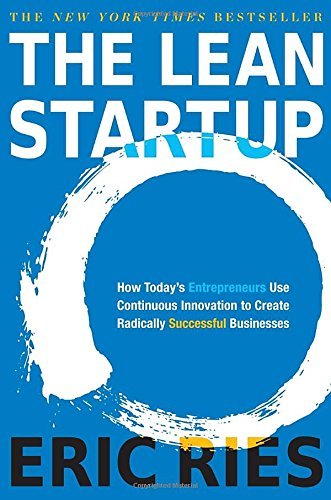
Most startups fail. But many of those failures are preventable. The Lean Startup is a new approach being adopted across the globe, changing the way companies are built and new products are launched. Eric Ries defines a startup as an organization dedicated to creating something new under conditions of extreme uncertainty. This is just as true for one person in a garage or a group of seasoned professionals in a Fortune 500 boardroom. What they have in common is a mission to penetrate that fog of uncertainty to discover a successful path to a sustainable business.
12. Start Your Own Business, Sixth Edition: The Only Startup Book You’ll Ever Need by The Staff of Entrepreneur Media

Tapping into more than 33 years of small business expertise, the staff at Entrepreneur Media takes today’s entrepreneurs beyond opening their doors and through the first three years of ownership. This revised edition features amended chapters on choosing a business, adding partners, getting funded, and managing the business structure and employees, and also includes help understanding the latest tax and healthcare reform information and legalities.
13. The Purpose Is Profit: The Truth about Starting and Building Your Own Business by Ed ”Skip” McLaughlin
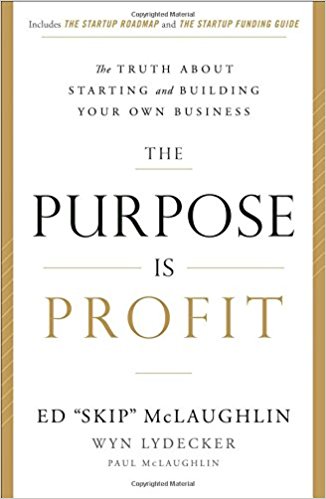
The book eliminates the mystery of becoming an entrepreneur. You will learn: why distinctive competence trumps passion,where and when to get funding without losing control, how to build an entrepreneurial brand that lasts, why profit should be factored into every business decision, how ethical behavior breeds trust and unlocks profit. As a bonus, The Purpose Is Profit includes two manuals: The Startup Roadmap details the 21 steps you should take to build a profitable business. The Startup Funding Guide delivers the tools you need to fund your business.
14. $100 Startup by Chris Guillebeau

In preparing to write this book, Chris identified 1,500 individuals who have built businesses earning $50,000 or more from a modest investment (in many cases, $100 or less), and from that group he’s chosen to focus on the 50 most intriguing case studies. In nearly all cases, people with no special skills discovered aspects of their personal passions that could be monetized, and were able to restructure their lives in ways that gave them greater freedom and fulfillment.
In the book he wrote are the most valuable lessons from those who’ve learned how to turn what they do into a gateway to self-fulfillment. It’s all about finding the intersection between your “expertise” – even if you don’t consider it such — and what other people will pay for.
15. Zero to One by Peter Thiel

The book presents at once an optimistic view of the future of progress in America and a new way of thinking about innovation: it starts by learning to ask the questions that lead you to find value in unexpected places. Thiel begins with the contrarian premise that we live in an age of technological stagnation, even if we’re too distracted by shiny mobile devices to notice. Information technology has improved rapidly, but there is no reason why progress should be limited to computers or Silicon Valley. Progress can be achieved in any industry or area of business. It comes from the most important skill that every leader must master: learning to think for yourself.
16. The Founder’s Dilemmas by Noam Wasserman
17. Tools of Titans by Tim Ferriss
The latest groundbreaking tome from Tim Ferriss, the #1 New York Times best-selling author of The 4-Hour Workweek.
18. Crushing It: How Great Entrepreneurs Build Their Business and Influence-and How You Can, Too by Gary Vaynerchuk

This new book chronicles brand new lessons, strategies, tactics, advice and inspiration pulled straight from both his own amplified business experience and that of dozens of other influencers and entrepreneurs from around the world. Vaynerchuk offers fresh tactical advice on how to become a household brand on social channels like Twitter, Facebook, YouTube, Instagram, and Snapchat; podcast platforms like Spotify, Soundcloud, iHeartRadio, and iTunes; and other emerging platforms like Musical.ly.
If you’re looking to build a brand that can grow your business, this is a must-read business book for the year. And though it’s a guide to building your own path to professional and financial success, remember that it’s not about getting rich. It’s about living life on your own terms, wrote ryrob.com.
19. The Startup Hero’s Pledge by Tim Draper
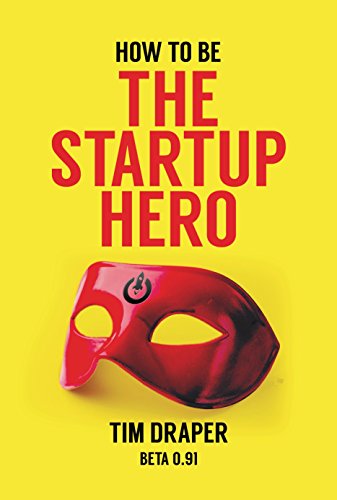
Startup Heroes are the ones that drive progress, and whether you bring us to another planet or make your neighborhood a nicer, happier place, you can become a Startup Hero. This book is the first step. It helps you take that first step. The step will be different for everyone. It might be to call that customer. It might be to draw up a design concept. It might be to talk to your boss. With this book, I hope to guide people to think big, drive change and go full speed ahead. I am giving them a pledge to do their work for good, and I am giving them some of the tools they need to accomplish their goals. – Tim Draper
20. Rework by Jason Fried
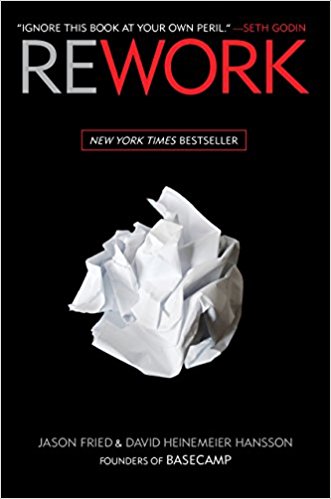
Most business books give you the same old advice: Write a business plan, study the competition, seek investors, etc. If you’re looking for a book like that, put this one back on the shelf. Read it and you’ll know why plans are actually harmful, why you don’t need outside investors, and why you’re better off ignoring the competition. The truth is, you need less than you think. You don’t need to be a workaholic. You don’t need to staff up. You don’t need to waste time on paperwork or meetings. You don’t even need an office. Those are all just excuses.
Best Photo Noise Reduction Apps in 2018
“Image noise” or “digital noise” is a common problem. When you click photos in low light conditions or not with a great camera, image clarity suffers. The image is suffused with tiny dots making it look grainy and distorted. Noise is actually the disturbance of pixels due to which the colors of pictures are not depicted properly.
Shoot at lower ISO settings: ISO settings in your camera decides the noise level in your photos. Generally, higher ISO settings cause more noise in your images. Different cameras work well at different ISO settings though keeping ISO level low is advisable. Shooting at lower ISO means there will be less noise in your image. Higher ISO settings translated as a grouping of pixels together to capture more light. Hence this grouping effect can create more noise in your image. To avoid this, you can open your aperture to its widest settings or if you are shooting in a low light then you can use a tripod or a flash. Using “Auto ISO” feature should be your preference as then the camera itself decides the right level of ISO settings as per the light and other conditions like shutter speed etc. – articlecube.com
What you can do to change the situation is use a professional photo noise reducer software or app. We found some for you and here they are:
The free app makes your photos look sharper and clearer. Whether the photos have been clicked in low-light condition, at a high ISO setting or with an average camera, the tool promises to help reduce noise in your photos. With the automated features of Noise Reducer Pro, you can effortlessly de-noise the digitally distorted images. Its features include: real-time comparison, auto-mode, zero-click noise fixer, quality adjuster,etc.
It removes the noise and sharpens the details making the images look beautiful as ever. It is an effective noise reducer software which supports RAW, TIFF 8-bit, 16-bit, PNG, JPEG formats. It provides pixel-perfect detail recovery after the noise reduction. It has powerful adjust panel to fine-tune & enhance the image, getting natural, crisp and clear images.
The unique scene-detection technology analyses your surroundings instantly, suggesting the best mode for your shot. From dusky evening scenes and low-light indoor shots to bright, high-contrast environments, ASUS PixelMaster Camera enables effortless mode-switching.
A number of top ranked Android camera apps such as HDR Camera+, Night Camera+ and HD Panorama+ have been melted into A Better Camera to provide you with the best, all-purpose, full featured camera app. Video has great features, such as time lapse, and can be used with focus lock, exposure lock and white balance lock. Being open to 3rd party developers, this application aggregates the experience of Android developers community to provide you with the most complete set of the best imaging features.
It supports exporting and resizing multiple photos and includes tools for editing and exporting metadata and IPTC. Full featured photo editor: crop, straighten, color adjustments (including histogram and curves), sharpen and denoise, retouch tools and more. At the same time, it can open up for editing very large files and supports an export resolution of up to 21 MP.
Designed to remove visible noise, distortion of pixels, and noisy grains from the photographs. Neat Image is an idle tool for shooting in low-light conditions and for photographers who take interests in high-speed photography. It reduces the noise of the images having high ISO noise captured by image sensors of digital cameras, film grain visible in scanned images, and color banding.
Use Adobe Photoshop Express to create better looking pictures. Use slide bar adjustments or automatic one-touch fixes to achieve great results. The Noise Reduction function minimizes unwanted grain and speckling in night photos and other low light photos.
It is an effective Photoshop plugin which aims to reduce noise in photos and also removes distortion from digital photographs. If you love low light photography or capture fast moving photographs, like, News, sports, and events then this is the perfect tool for you. Moreover,the app is a professional-grade RAW converter that delivers exceptional detail, outstanding image quality, and a distinctive, natural look.
More you can find here and here.
How much time people spend connected to their smart devices?
How much time people spend connected to their smart devices?
The short answer is all the time!
But what all the time means exactly?
Let’s dig in a little deeper!
The 2018 Digital Future in Focus report from ComScore shows very interesting statistics related to our smart devices usage and consumption.
The report investigated 13 countries: USA, Canada, France, Germany, Italy, Spain, UK, Argentina, Brazil, Mexico, India, Indonesia and Malaysia.
Here are our main takeaways:
1.average time spent on connected smart devices: 4 hours
2. multi-platformers (mobile, desktop/laptop, tablet) remain a majority in most markets (46%), mobile only usage is 30% and desktop only – 24%; the countries that stand out is India (80% are multi-platformers) and France (60% desktop users)
3. multi-platformers consumption is still the norm, but mobile only is on the rise
4. mobile users consume more than twice minutes compared to desktop users (e.g.: Argentina 7000 minutes, Canada 2000 minutes)
5. entertainment and video flourish on mobile platforms

6. smartphone takes largest share of global digital minutes
7. here is the top 5 apps by reach

8. mobile apps account for over 80% of mobile time
9. mobile-only audiences are now second only to multi-platform users
10. Amazon sites are slowly surpassing Facebook and Google sites
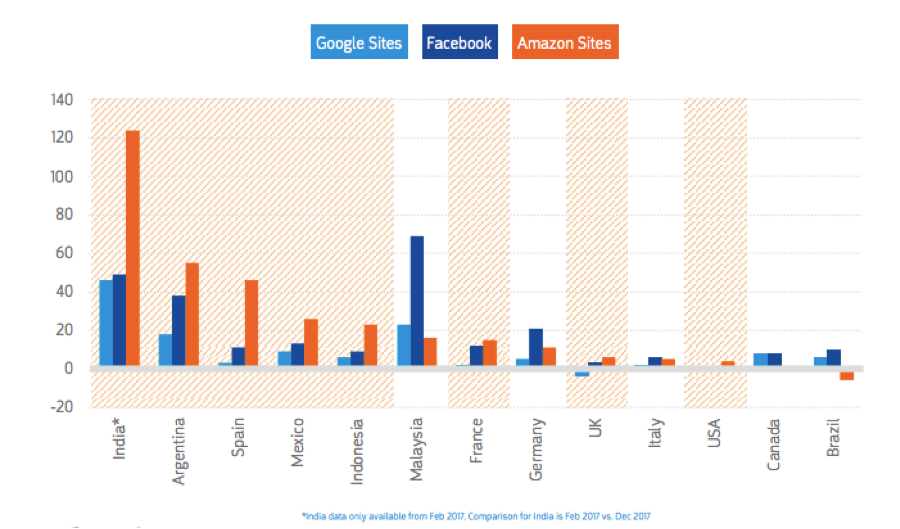
11. markets which have a mobile audience larger than its desktop audience: India, Indonesia, Mexico, Spain, Brazil, Italy and Malaysia
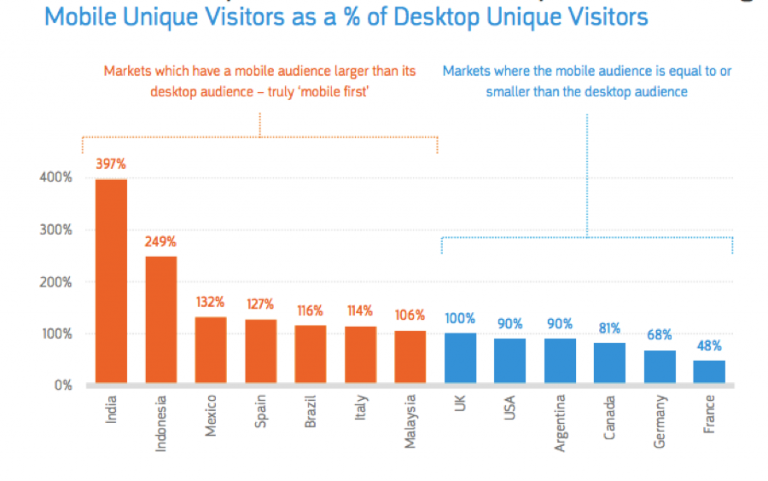
12. markets where the mobile audience is equal to or smaller than the desktop audience: UK, USA, Argentina, Canada, Germany and France
13. in the majority of markets, retail has higher proportional audience reach among mobile users than desktop, with Spain leading by 97,5%; at the other end of the spectrum, there are Germany, Italy and Malaysia where users access retail by desktop
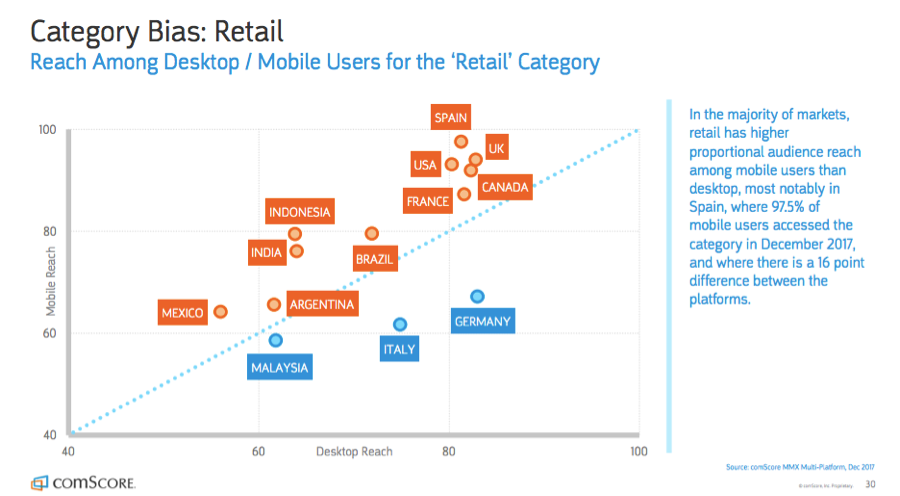
14. when it comes to news and information, 80% of users in all markets access this category by mobile, except Canada where 95% of users turn to desktop
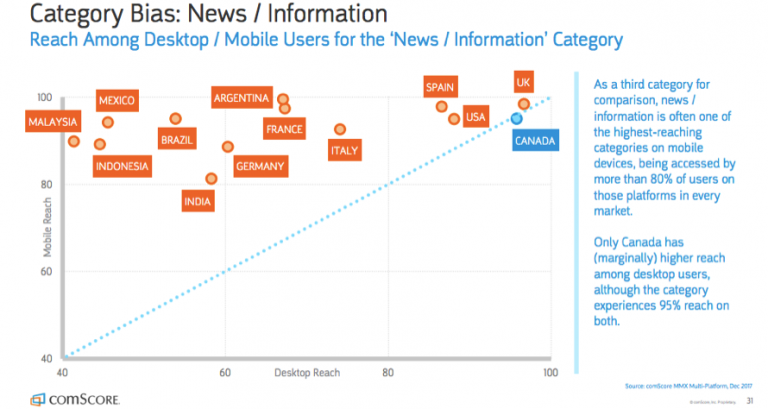
15. people use their app minutes for the following categories in this order: social media, entertainment, instant messaging and games
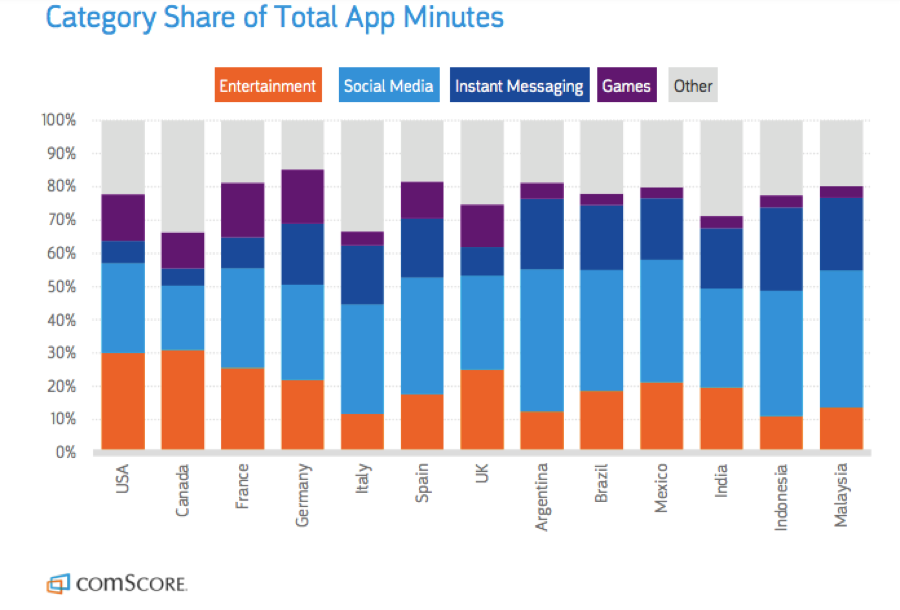
16. the most popular social network is Facebook by far, followed by Instagram, Snapchat and Twitter

17. most popular instant messaging app is WhatsApp Messenger, followed by Facebook Messenger and WeChat
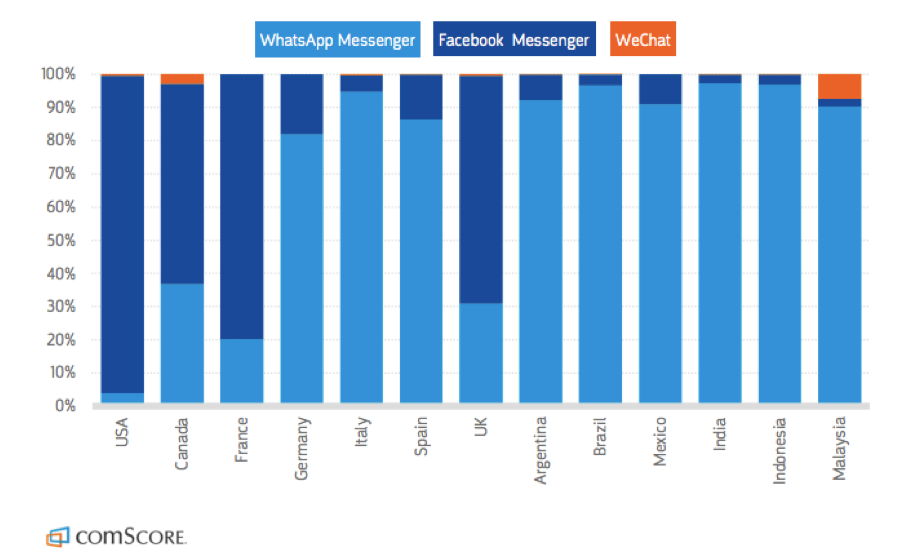
screenshots: comscore.com
Outlook gets new features for the business users
Gmail and Outlook have been neck to neck in the last years in the fight for the business users. We wrote about it here and here.
Now, after Gmail announced its latest interface and the new changes, especially for the business users, Outlook decided is high time to react. Microsoft announced a number of new Outlook features across Windows, Mac, web, and mobile to help professionals be more productive on the platform. The features aim to help professionals better manage their time and prioritize tasks, according to a Microsoft blog post. They can also better connect users to the people, apps, and technology that power productivity, and protect businesses.
The main changes are as follows:
Bill pay reminders
Outlook will identify bills you receive in email, show you a summary at the top, and automatically add a calendar event on the due date. You will also receive an email reminder two days before the due date so you can always pay your bills on time.

Suggested event locations and meeting rooms
When booking a meeting, Outlook will offer suggestions for the meeting location, including recently used and available conference rooms or other locations. For meetings outside the office, Outlook will add the full address, and use your current address and traffic information to send a notification when it is time to leave. This feature is only currently available in Outlook for Windows.
When creating a calendar event in Outlook for iOS, machine learning models will consider your location, the list of attendees, the proposed meeting time, and other elements to suggest a meeting location, which a user can then book with just a tap on their phone, according to the post.
Meeting RSVP tracking and forwarding
Keeping track of events you’ve organized or plan to attend is key to time management. But managing who is attending can be even more effective for everyone. Outlook now allows you to see the tracked responses and RSVPs for your meetings—
Outlook has also adjusted the tracking of RSVPs for meetings with large attendee lists or big meetings. If you use a distribution list to reach over 500 recipients, Outlook now tracks the responses for everyone individually. Now you can update the details for big meetings at any time if changes are required, outside the Office 365 email and calendar recipient maximum of 500.

Multiple time zones
Outlook reduces the complexity of managing events across times zones. You can now define the start and end times of appointments and meetings across different time zones. Set up a travel event with your departure in one time zone and arrival time in the local time zone of your destination. Plus, on the main calendar grid, you can now show multiple time zones in Outlook. In Windows, you can add up to three time zones. In Mac, add one additional time zone.
Show organization directory details
Outlook now adds the details of your organization directory to your Outlook contact information. The new feature can be found under Show Organization, so you can quickly learn who’s who in your company. If your company data is connected to Azure Active Directory, you can see who your contact reports to, their chain of command in your company, and even other colleagues they work with most. Knowing more about who might help you take care of business is right there in Outlook. You can simply tap search in your Outlook mobile app once to quickly identify your key contact, open their contact card, and view their organizational information.
Proxy support
Some organizations have adopted the use of proxies to block direct access to the internet from mobile devices. Now Outlook supports companies that use SOCKS proxies for added protection between their company data and the internet.
Bcc warning
It may happen to be blind copied on an email message and you’d like to respond. Outlook protects you if you reply to that message by alerting you that you were blind copied—
The A to Z of How To Organize A Pitch -part II
Last week we started to present you a series of steps you musttake in order to make sure you organize a good pitch. Today we continue with Cristina Oncescu’s opinion, by presenting you the rest of your journey.
How should the brief look like?
What makes a good brief is not the form, a list of boxes to fill-in, but some basic principles which can be applied to almost any briefing situation. There are three basic principles from IPA:
- Be clear about what is needed
- Provide the critical information necessary to complete the task
- Inspire or motivate people to do their best
These principles apply equally to briefing marketing communications as briefing many other things in life. Often with marketing communications we make it over-complicated and forget the basic principles ending up with the agency being unclear on what is required. In other areas of life we do things more instinctively and use the most efficient means of briefing – for example, it’s sometimes faster and more accurate to brief a hairdresser by using a picture rather than a verbal description.
Clarity of objectives
It seems self-evident that the most important part of a brief is a clear description of what the aim of the brief is. Yet in our industry review of briefing techniques this is consistently the weakest area of written briefs. It is often confused with overall business, brand or marketing objectives, whereas the single most important content section is the communication objective itself. Some briefs simply describe the sales target without any thought as to the role of communications.
Agencies need this clarity and it is the responsibility of the person writing the communications brief to provide this.
A brief should be just that
Aim for a brief that is succinct and memorable. If it isn’t, it’s likely to be less effective. At the very least aim for something which can be remembered when the piece of paper is not in front of the person or team that has been briefed – if the writer of the brief can’t even remember what it was about without a prompt, what chance is there of others internalizing what is required?
Of course there is room for attachments and additional material. Sometimes a large volume of background material can be helpful as one seemingly small bit of information could prompt a thought that leads to the solution. But best practice is to provide only the critical information that is relevant to the task. Why make agency people wade through masses of irrelevant information? Often it is a lack of thought that leads to this approach.
As Blaise Pascal wrote as long ago as 1657: “I have made this letter longer, because I have not had the time to make it shorter.”
Fundamentally brief writing is about making decisions about what is needed. Deciding what to leave out is part of that. Whilst there may be a need to provide greater depth of supporting material, the overall brief itself still needs to be simple and clear.
Inspired to greatness
When asking marketing people ’What makes a good brief?’, the answers are mostly about objectives, requirements, target audience etc. Only on prompting do people recognize that inspiring the agency or the team to produce great work is a critical element. Perhaps clients assume that an agency will be motivated enough by remuneration, the fear of losing the business, or simply by any opportunity to do good work.
However experience shows that those clients who not only put more thought into their brief, but also use their own creativity to make briefing the agency or agencies an inspiring experience, tend to get better results. There are three main reasons for this: firstly the brief will stand out from the other assignments that the agency is working on and get an unfair share of attention. Secondly a client who has put more thought into the presentation of their brief is likely to have greater empathy for agency psychology and the creative process making it more likely that they have provided the springboard for a great creative leap. Thirdly a client who delivers a great brief signals that they are in the market for a great creative response, and likely to be excited rather than frightened by one.
Most marcoms briefs also act as a business process document to initiate a job start – in effect it’s a purchase order and since large sums of money will be involved in both time and resources it needs to be taken very seriously.
Majority of those briefs have three broad areas of heading: the background, the brief itself, and an implementation and process section.
The background headers might include
Background: Usually covers the business and marketing context and why the task is important
Marketing or Sales Objectives: This sometimes includes the business case for the activity
Brand: Remarkably this is often overlooked. It might include brand identity/brand capsule/brand vision/brand architecture/brand status/brand values/brand personality
Previous Learning: Again a section which is only used occasionally, but may have wider potential
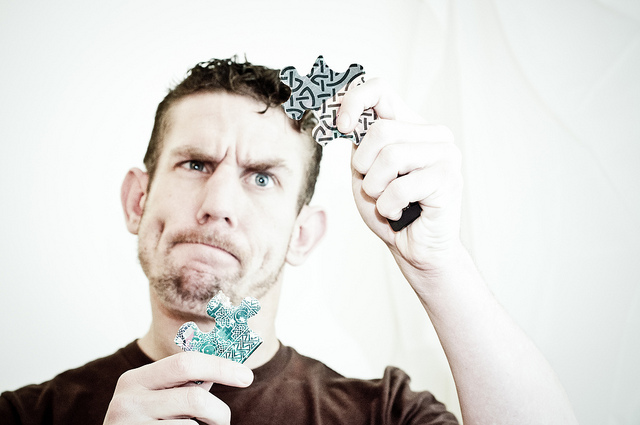
The main communications brief section headers might include:
Communications objectives: Sometimes they might be expressed as communications imperatives/ challenges/barriers
Target audience: Usually this section asks for more than simple demographics and specifically prompts for attitudes or other motivators
Consumer insights: Sometimes specifically linked to the objective
Key message/proposition: Often phrased as the single-minded proposition/the one thing we want to say
OR
Strategic benefit: May ask for emotional and functional benefits
Consumer takeout: What they will think or do
Tone of voice: As distinct from brand personality
The implementation and process headers might include:
Timings/key dates: May include project timelines as well as timing for response
Budget: May specify if production is included or not
Response mechanisms: On relevant types of brief
Evaluation/success criteria: A critical element for most disciplines
Mandatories/guidelines: May include what must be included and executional considerations
Approvals: Signatures of both those issuing/approving the brief and the agency
The choice of ‘proposition/message’ or ‘strategic benefit’ is one which reflects the thinking of the organization and the relationship with their agencies. The use of a ‘proposition’ on the marcomms brief can be quite closely related to how many agencies use a ‘proposition’ in their own creative briefs. This could be seen positively as aligning thinking. An alternative view is that the role of the communications brief is to be clear about what the benefit is, and leave it up to the agency to think through how to best express that as a compelling proposition. This is largely a matter of style.
Main criteria for choosing the winner
The agency that scores best on the announced evaluation criteria, given that the client has held before a proper selection process, including background fitting and chemistry meetings.
Larks versus Owls – How Is It Helping You Professionally Or Not
Like the world around us, our biological clocks are set to tick in cycles of approximately 24 hours. We are designed to sleep and wake in cycles of roughly 24 hours, otherwise known as our basic circadian rhythm. Many of the body’s major systems run on circadian rhythms. Cardiovascular activity has a circadian pattern, as does body temperature, metabolic functions and liver and kidney function.
“Yet, it is increasingly common for people to override basic biorhythms and ignore the biological signals for sleep. Stimulation is available around the clock in the form of the internet, to name just one attraction. According to Dr. Roseanne Armitage, an expert on sleep at the University of Michigan, the sleep patterns of Americans are getting worse, increasingly out of phase with the natural rhythm. People are staying up later than ever and it’s happening at a progressively younger age,” wrote Psychology Today.
Moreover, as the publication shows, in addition to the body rhythms set to the day, there are other body rhythms occurring in cycles of shorter duration, often multiple times during the day. These are known as ultradian rhythms. “With these, too, biological and psychological alertness and performance are very strongly correlated to the synchronization of your actions with the body’s natural patterns. Staying in tune with your body’s cycles puts you in line to achieve peak performance. Failure to synchronize your patterns of activity and stimulation with your body’s natural circadian and ultradian rhythms puts a stress on the system,” added Psychology Today.
At the same time, as livescience.com points out, right from birth, our personal biological clocks are already wound. Genetics establishes a person’s “chronotype”. “People span the range of those who are very early risers to very late setters, and this is genetically determined,” said Frederick Brown, a professor of psychology at Penn State, quoted by the publication.
Still, to a certain extent, behavior and environment can shift our built-in predispositions. But for those of us that are for sure in one chronotype camp or the other, in the end, the body decides. “If you’re a morning-type person, you can’t become an evening type, and vice versa,” said Brown, quoted by livescience.com.
Hormones and body temperature also differ between the sleep groups. Early birds have higher levels of cortisol in the morning, which may give them the perky edge. Our sleep preferences are at least in part hereditary. Differences in the CLOCK gene may contribute to differences in our favored times of activity. Sleep researchers at Stanford University found that people with one genotype had an increased preference for eveningness, while the other genotype had an increased preference for morningness.
When it comes to sleeping and working preferences, there are two main types of persons: “Larks” (love to wake up in the morning, that being the time when they are active and in-shape and go to sleep early) and “Owls” that are most alert at night, and typically turn in long after dark.
According to Paste Magazine:
Larks: Resilient and Realistic
Morning types show more conscientiousness, resilience and persistence. Larks are also more likely to be academically successful. These early birds “trust direct experience and observable phenomena; they prefer to process knowledge using analysis and logic,” say the investigators of a 2015 study of Facebook users, citing research by co-author Juan Francisco Diaz-Morales, Ph.D., M.D., of the Universidad Complutense de Madrid. Larks also tend to be self-controlled, respectful and cooperative.
Night Owls: Adventurous and Outgoing
On the other hand, attraction to evening is associated with intelligence, openness to new experiences, extraversion, risk-taking and impulsivity. Evening types may be more imaginative and intuitive, according to the Facebook study; research suggests they tend to be creative thinkers and innovators.
“A few studies show that character traits may differ between the diurnal and the nocturnal. A Spanish researcher found that the time of day we prefer to be most active corresponds to certain personality traits. Early risers were more likely to be logical and analytical, and likely to use concrete information as sources of knowledge, whereas those that stayed up late were more imaginative and intuitive. Another study published in the February 2007 issue of Personality and Individual Differences determined that night owls scored better on creativity tests than did intermediary and morning people,” wrote care2.com.
Here you can find some conclusions about both types, based on research and several studies done during the years.
Blockchain and cryptocurrency: what’s the difference?
What is blockchain?
Blockchain is a digital ledger in which transactions made in Bitcoin or another cryptocurrency are recorded chronologically and publicly. It allows digital information to be distributed but not copied.
Many have compared the blockchain with a spreadsheet: the spreadsheet is duplicated thousands of times across a network of computers and this network is designed to regularly update this spreadsheet. The blockchain is transparent and cannot be corrupted, it isn’t controlled by any single entity and it is not flawed.
What is cryptocurrency?
The cryptocurrency is a digital currency in which encryption techniques are used to regulate the generation of units of currency and verify the transfer of funds, operating independently of a central bank.
Bitcoin is the first cryptocurrency or “digital gold”. But unlike USD or EURO, cryptocurrencies are not issued by a bank or owned by a country, don’t fall under the influence of political regimes and are private and anonymous enough to be used as means of payment worldwide. Bitcoins can be traded for goods or services with vendors who accept Bitcoins as payment.
A Short History of Blockchain and Cryptocurrency
Blockchain is a technology invented and developed by a person or a group of persons known as Satoshi Nakamoto.
In October 2008, Nakamoto published “Bitcoin: A Peer-to-Peer Electronic Cash System”, the first paper describing the bitcoin digital currency.
In January 2009, Nakamoto released the first Bitcoin software that launched the network and the first units of the Bitcoin cryptocurrency, called Bitcoins. Nakamoto created a website with the domain name bitcoin.org and continued to collaborate with other developers on the Bitcoin software until mid-2010. Around this time, he handed over control of the source code repository and network alert key to Gavin Andresen, transferred several related domains to various prominent members of the Bitcoin community, and stopped his involvement in the project. Until shortly before his absence and handover, Nakamoto made all modifications to the source code himself.
How does blockchain and cryptocurrency work?
The blockchain is a digital technology that allows value exchange without the need for trust or for a central authority. It is a secure, quick and cheap technology. As mentioned in its definition, blockchain uses a ledger, which is a digital file that keeps track of all Bitcoin transactions.
The ledger file is not stored in a central entity servers, like a bank, or in a single data center. It is distributed across the world via a network of private computers that are both storing data and executing computations. Each of these computers represents a “node” of the blockchain network and has a copy of the ledger file.
In order to be able to perform transactions on the blockchain, you need a wallet, a program that allows you to store and exchange your Bitcoins. Since only you should be able to spend your Bitcoins, each wallet is protected by a special cryptographic method that uses a unique pair of different but connected keys: a private and a public key.
Once you have installed a Bitcoin wallet on your computer or mobile phone, it will generate your first Bitcoin address and you can create more whenever you need one. You can disclose your addresses to your friends so that they can pay you or vice versa. In fact, this is pretty similar to how email works, except that Bitcoin addresses should only be used once.
Here is a short explaining video:
Snapchat’s Spectacles v2 are here
According to Statista‘s data, despite its origins as a photo app, video has become an important feature of Snapchat, with more than 10 billion mobile videos currently viewed per day, rivaling Facebook in terms of daily video user engagement. The company reported 100 million daily active users worldwide in May 2015, positioning it as one of the fastest growing social apps and networks worldwide. Snapchat also ranks as the most popular social media site among teenagers and young adults in the United States. During the first quarter of 2017, Snapchat reported 166 million daily active users worldwide.
“The platform has also become a cornerstone of social media marketing towards teens and Millennials. Snapchat users are also willing to pay for online and mobile content, with music downloads and TV and movie streaming being the most popular types of paid content. Visually strong brands such as sportswear, beauty and fashion are leading the way in terms of Snapchat adoption. The platform generates the majority of its revenues via advertising and branded content. In the first quarter of 2017, Snapchat’s revenue amounted to 149.6 million U.S. dollars. The global revenue for 2017 being 825 millions USD,” added Statista.
In this context, Snapchat launched Spectacles v2 that are now more comfortable to wear with a smaller profile and water resistant. Tap the button to record video with new and improved audio, and now, you can press and hold to take a photo! Snaps you capture will transfer to Snapchat up to four times faster, and always in HD. Snap Inc. actually reduced the field of vision for Spectacles from 115 to 105 degrees to cut off some of the fish-eye warping that happened to the edges of clips shot on V1. Videos now record in 1216 x 1216 pixels, while photos are 1642 x 1642.
“The new Spectacles have the same battery life and charging capabilities from the first model, even though the glasses and case are both now slimmer. Expect 70 or so video snaps before your Spectacles run out of battery, and the case can recharge your glasses about four times before it needs more juice. Moreover, importing snaps from Spectacles to your phone is quicker than before, but the fact remains: You have to wait until your snaps reach your phone before you can do anything with them, which isn’t always convenient — and you’re going to need to transfer quite often,” wrote Business Insider.
The A to Z of How To Organize A Pitch – part I
The time when a client decides to make a pitch for the communication agency (either it’s a PR, advertising, digital or social media one) is extremely important in its business path. In order to make sure it’s a well spent time both for him/her and the company is representing, but also for the agencies involved, the client must be sure of a certain guide pitch , of a series of “rules” that will make their lives easier and also will lead to a successful result.

We talked with Cristina Oncescu, Head of Strategy pastel, and she put down some guidelines that will help you a lot.
What should a client know and must take in consideration when organizing a pitch?
Before organizing a pitch, a client should take time to carefully consider if they really need to change the current agency. Therefore the Institute of Practitioners in Advertising (IPA) recommends the following points to consider before embarking on an agency search:
Why are they organizing the pitch
The client should be very clear that changing agency would be in the best interests of the brand or the business organization, and will bring future value. Before embarking on a search for a new agency, he must be really sure that best efforts have been made to restore the existing client-agency relationship to health.
Have full support from top management
If a pitch is deemed to be the right course of action, the marketing or corporate communication must ensure that the client company’s top management fully endorse it, and that the key decision makers are clearly identified and enlisted in the process.
Consider getting outside help
It is advisable to seek outside professional help from specialist consultants, if considered suitable for the client company. The process is more objective, and dealing with the incumbent agency less unpleasant.
Check the contracts
Before the process begins, the client should check the provisions within the contract with the incumbent agency, particularly with regard to the notice period and termination of contract.
Inform the current agency
The client should consider the implications of informing existing agency that the pitch is taking place, weighing the need for confidentiality against the scenario of the incumbent finding out about the pitch from a source other than their client.
Decide the role to play by the new agency
The client should decide whether he is acting as the orchestrator of a series of agency relationships, he needs a ‘lead’ agency, or he requires a ‘one-stop-shop’.
Have a clear brief
The pitch organizing team should gain full agreement with all those involved in the decision making process about what the requirements of the agency are. They must invest time and effort in agreeing the budget and producing a written brief describing the brand or company’s current position, and where it wants to be in the context of clear marketing and business objectives.
Decide the kind of pitch to hold
Give some thought to the type of search that will best assist the client in making the appointment. The traditional pitch process is expensive for both parties, so agree fees where appropriate to offset a fair proportion of agency costs and to ensure a professional approach on both sides. Understand that many successful agency appointments are based on reputation, personal chemistry, credentials and references from other clients, as opposed to pitches. Workshops and trial projects are also effective methods of choosing an agency. Equally, online ‘e- sourcing’ techniques may help in the initial stages of researching the marketplace, but they should not replace the face-to-face contact which is so important in conducting a successful review and selection process.

If the client has checked the above and ended deciding to go through the pitch process, here are the steps:
- Prepare all the necessary background information
- Prepare an outline brief, including a clear indication of the brand or company marketing/communications budget. Consider the scope of work you will be asking the successful agency to undertake and ask the agencies to prepare some initial financial estimates accordingly, right at the outset. This avoids misunderstandings and manages expectations on both sides.
- If the client has chosen a consultant to help manage the selection process, work with them to develop a brief on the type of agency required, e.g. in terms of size relative to budget, location, and specialization, potentially conflicting business, etc. and draw up carefully the criteria that will form your checklist against which to judge the initial agency longlist.
- Identify relevant existing work for other clients, within the appropriate communications discipline, which they rate highly.
- Talk to colleagues in their own and other companies about their agency experiences.
- Undertake any necessary desk/online research, consulting agency directories, agency trade associations, and the trade press for additional background information about agencies that might interest you.
- Public sector clients need to ensure that their agency search and selection process is compliant with any public procurement regulations.
- Hold chemistry meetings and sign a confidentiality agreement
- Client should seek credentials information and case studies from, and hold initial chemistry meetings with, selected agencies that match the criteria in your outline brief.
- A confidentiality agreement must to be signed before undertaking any meetings. It is of benefit to both parties to enter into such an agreement, which should cover information and materials supplied by the client for the pitch and those produced by the agency in response.
- Client should decide whether to make a monetary contribution to the pitch. If so, this can be included in the non-disclosure agreement to form part of a wider pitch agreement. Some financial contribution (announced upfront and the same offer to all agencies on the shortlist) shows commitment and the seriousness of their intent.
- Think of the response required and prepare a written brief accordingly
- Prepare a concise but thorough written brief for the competing agencies. It is advisable to clarify if the pitch is a statutory one.
- It must be clear from the brief whether strategic proposals alone are required, whether some creative ideas or a full creative pitch are expected, or whether a workshop or trial project is envisaged. Agencies should respect the client’s wishes in this. The client should understand that creative pitches are an expensive and resource-draining exercise for agencies.
- Be clear about the nature of the services that they expect to use the agency for (e.g. some or all of brand planning/strategic thinking, communications planning, creative development, media planning and buying, digital, PR, events, etc.).
- Make the budget explicit from the outset.
- Identify and make clear all criteria on which the agencies’ presentations will be judged (e.g. strategic thinking, creative concepts, costing proposals, etc.).
- Specify the time allowed for meetings or presentations. If pitches are to take place at client premises, advise agencies on the presentation facilities available, size and nature of meeting rooms, number of participants, etc.
- Be disciplined on how many agencies are invited to respond to a preliminary ‘Request for Information’ (RFI). Asking more than 10 agencies is usually very wasteful of both client procurement and agency resources, and indicates an unclear brief. Good consultants will usually advise fewer than this to ensure a deeper focus on the agencies genuinely in contention.
- No more than six agencies should be asked to prepare extended credentials or ‘think-piece’ presentations for shortlisting.
- Invite up to three agencies to pitch (or four if incumbent included)
- Decide positively on a pitch list of up to three agencies only. If the incumbent is invited, the list can go up to four agencies in total.
- The client should not invite the incumbent to pitch if they have no intention of re-appointing them. Talk to the incumbent about why they are not including them in the shortlist.
- Avoid being seduced into lengthening the list.
- Make competing agencies aware of the number of agencies on the pitch list and whether the incumbent is included. The client should confirm in writing whether or not the pitch process and the names of the participants are confidential.

- Consider the time necessary for response to the brief
- Allow sufficient time for agencies to have face-to-face meetings to discuss the brief, ask questions, and to talk through their initial thinking. Don’t underestimate the value of informal meetings with the competing agencies in helping you to evaluate team ‘fit’.
- If the client decides to use a workshop approach, build in sufficient time to implement this process, including scheduling diary time for key personnel involved in the selection team.
- Time must be allowed for development of constructive ideas between brief and presentation. Bearing in mind that full proposals can take weeks or months to develop in an ongoing relationship, four weeks minimum is suggested for the development of work for a full creative pitch. Different pitch approaches, such as extended credentials, ‘think-pieces’, strategic recommendations, and workshops, can take less time and still be effective.
- Give background market data, interpretation and clarification
- The client should be willing to share, on a confidential basis, the overall business/corporate objectives, market data and other relevant research and allow agency personnel access to people in the company with whom they would work, if appointed.
- Make sure that there is always a specified senior member of the client’s company to handle all enquiries and meet requests of the agency to ensure consistency of response. Don’t underestimate the time involved of someone being fully available over a short period of time.
- Avoid giving the answers to one agency’s carefully considered questions to all the competing agencies (unless those questions highlight important information which should have been included in the original brief).
- Allow the same rules of access to all agencies pitching.
- Agree basic contractual terms upfront
- It is not usually in the interests of either the client or the agencies involved to spend time and money on negotiating full contract terms at this stage of the selection process, but the fundamental terms of business (such as budget, basic remuneration and scope of work) should be addressed in a Heads of Terms agreement.
- However, should the client have fixed terms of business which are not open to negotiation, then these should be put on the table, up front and in full, to make sure the competing agencies are clear on the terms under which the contract will be awarded ultimately.
- Understand the roles of all those involved on both sides and set up an objective evaluation system
- Ensure that all the decision makers have been fully briefed and that they are all present at each stage.
- Advise the agencies of job titles and roles of those attending for the client.
- Establish an objective evaluation system for assessing each presentation.
- Ensure that the agency presentation teams include people who will actually work on the business.
- Decide and inform quickly and fairly
- Decide on the winning agency as soon as possible, normally no more than one week after all the agency presentations have taken place (except in those special cases where it has been agreed to put competing creative work into research).
- Establish a proper procedure for notifying both successful and unsuccessful agencies of the decision.
- Ensure that all participating agencies learn of the result on the same day. Once the client has established that the chosen agency would accept the appointment if selected, they should inform the unsuccessful agencies before confirming the decision with the successful one. This is usually the best way to ensure that the losers do not hear the bad news first from someone other than the client.
10.Key guidelines on implementation and relationship management
- After the pitch, give the losing agencies the courtesy of a full ‘lost order’ meeting. Use a feedback form based on previously announced evaluation criteria.
- Any losing agencies must return all confidential material and information provided – in whatever format – and the client must not use any of losing agencies’ pitch ideas or information provided during the pitch process.
- Honour the incumbent agency’s contract, particularly with regard to the agreed notice period and payment of outstanding invoices.
- Ensure that they co-operate fully in a hand-over to the new agency, making sure that all materials belonging to you are handed back in accordance with the contract.
- Commence formal contract negotiations, based on the Heads of Terms agreement, and ensure final contracts are signed by all parties. Allow sufficient, but not open-ended, time for this negotiation to take place.
- Welcome the winning agency into the start of a long-lasting and mutually satisfying relationship. Arrange thorough for mutual induction meetings to create familiarity between client and agency, ensure understanding of respective business processes, and manage expectations for the working relationship.
- Agree realistic objectives for brand or corporate communications, put measures of effectiveness in place and report key metrics regularly at CEO/main board level.
- Client-agency relationships are valuable and need active management: review and reinvest regularly in the relationship by the strategic use of brainstorms, ‘awaydays’ and refreshing the team with new people.
What are the main DON’Ts?
- Don’t do it if you can still fix the situation with your current agency. A pitch is expensive and time-consuming for both the client and the agencies involved.
- Don’t fish for ideas and never award a winner.
- Don’t appropriate ideas from non-winning agencies.
- Don’t do it without a clear brief.
- Don’t do it without having evaluation criteria. Make sure the agencies are aware of them.
- Don’t do it without a set budget. It’s frustrating to receive great ideas that cannot be implemented because they cost way more than the available budget.
- Don’t invite more than three agencies. Or four with the incumbent agency. Held a thorough pre-selection process before.
- Don’t do it without having clear evaluation criteria. Make sure the agencies are aware of them.
- Don’t take more time to announce the winner than it took the agencies to prepare the pitch proposals.
- Don’t avoid post-pitch meeting with non-winning agencies. Tell them why they didn’t win.
20 Must Read Books For Entrepreneurs in 2018 – Part I
In 2017 17 per cent more people searched “how to start a business” online compared to 2016, according to audience insights tool Hitwise, wrote The Independent.
We selected some of the best books we believe will help you on your journey as entrepreneurs:
1.Self Made: The Definitive Guide to Business Start-Up Success by Bianca Miller-Cole and Byron Cole

2. Good to Great: Why Some Companies Make the Leap and Others Don’t by Jim Collins
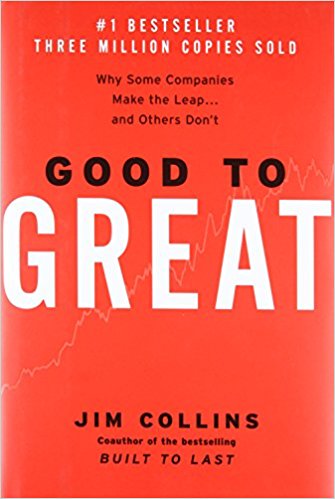
The findings of the book include:
- Level 5 Leaders: The research team was shocked to discover the type of leadership required to achieve greatness.
- The Hedgehog Concept: (Simplicity within the Three Circles): To go from good to great requires transcending the curse of competence.
- A Culture of Discipline: When you combine a culture of discipline with an ethic of entrepreneurship, you get the magical alchemy of great results. Technology Accelerators: Good-to-great companies think differently about the role of technology.
- The Flywheel and the Doom Loop: Those who launch radical change programs and wrenching restructurings will almost certainly fail to make the leap.
3. Built to Last: Successful Habits of Visionary Companies (Harper Business Essentials) by Jim Collins

Filled with hundreds of specific examples and organized into a coherent framework of practical concepts that can be applied by managers and entrepreneurs at all levels, Built to Last provides a master blueprint for building organizations that will prosper long into the 21st century and beyond.
4. Anything You Want: 40 Lessons for a New Kind of Entrepreneur by Derek Sivers
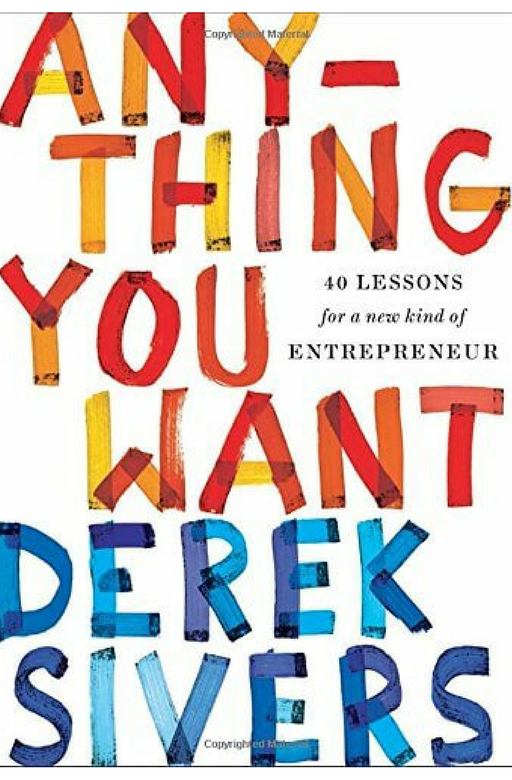
The writer let’s you in on everything he learned from starting, growing, and selling CD Baby, compressed into an entertaining and useful one-hour read. No secrets held back, I share the biggest mistakes, keys to its success, and the philosophies behind the big decisions. It’s 10 years of experience in one hour, designed to be immediately usable for your own business or project.
5. The New Business Road Test: What Entrepreneurs and Investors Should Do Before Launching by John Mullins
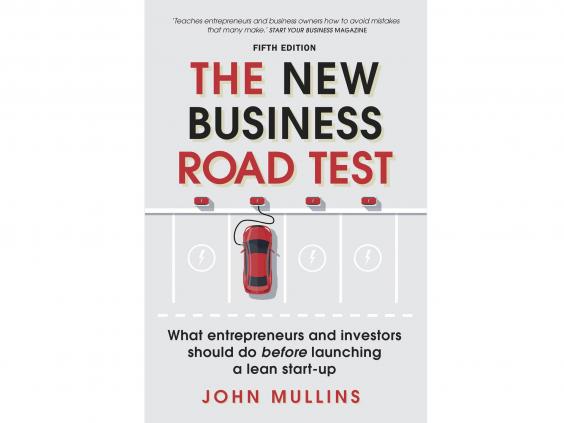
The New Business Road Test is the essential handbook for anyone wanting to launch a start-up. The new and fully updated case studies – Ella’s Kitchen, Whole Foods, eBay and more – and ‘seven domains’ framework will help you avoid impending disaster and enhance your chances of achieving your entrepreneurial dreams. “If you are looking to take a good look at whether your business idea will succeed or not then this is a useful, interesting and smart book to read. He also works hard on giving you the tools to assess if your idea has value or not, BEFORE you launch a lean startup, which makes this a useful addition to your library before you reach the Erik Ries stage,” wrote irishtechnews.ie.
6. The First 90 Days: Proven Strategies for Getting Up to Speed Faster and Smarter by Michael D. Watkins
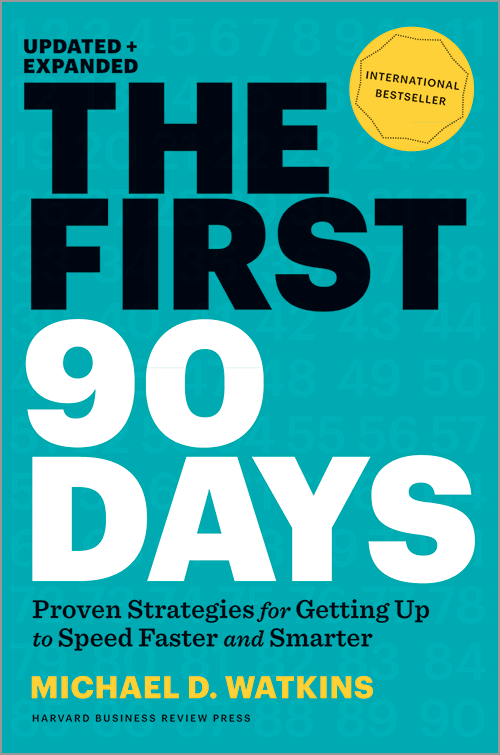
In this updated and expanded version of the international bestseller “The First 90 Days,” Michael D. Watkins offers proven strategies for conquering the challenges of transitions–no matter where you are in your career. According to hbr.org, Watkins, a noted expert on leadership transitions and adviser to senior leaders in all types of organizations, also addresses today’s increasingly demanding professional landscape, where managers face not only more frequent transitions but also steeper expectations once they step into their new jobs. By walking you through every aspect of the transition scenario, Watkins identifies the most common pitfalls new leaders encounter and provides the tools and strategies you need to avoid them. “You’ll learn how to secure critical early wins, an important first step in establishing yourself in your new role. Each chapter also includes checklists, practical tools, and self-assessments to help you assimilate key lessons and apply them to your own situation”.
7. Lost and Founder: A Painfully Honest Field Guide to the Startup World by Rand Fishkin

“Most people don’t want to talk about those startup stories, but the truth is, they’re a lot more common than the Zuckerberg-esque tales of success we so often hear about. Fishkin pulls back the curtain on tech startup mythology, exposing the ups and downs of startup life and sharing his hard-won lessons with you. No matter what business environment you’re in – whether it’s a struggling startup or a mature business, this book can help solve your problems. Or, at the very least, it’ll make you feel less alone for having them,” wrote sparktoro.com.
8. Made to Stick: Why Some Ideas Survive and Others Die by Chip Heath and Dan Heath
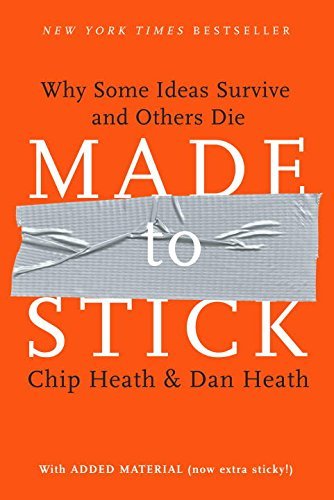
Since its release in 2007, Made to Stick has become popular with managers, marketers, teachers, ministers, entrepreneurs, and others who want to make their ideas stick. It’s been translated into Arabic, Bulgarian, Croatian, Dutch, and 25 other languages. Made to Stick made the New York Times and Wall Street Journal bestseller lists and was retired from the BusinessWeek list after a 24-month run. It was named to several “best of the year” lists and was selected as one of the best 100 business books of all time.
9. Recipe for Success: The Ingredients of a Profitable Food Business by Karen Green
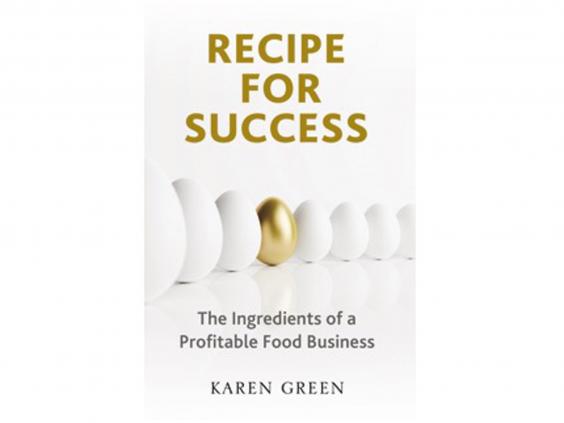
Karen Green, former UK retail buyer and commercial director for several successful food businesses, shares her stories, advice and exercises to guide readers through the maze of creating a profitable and growing food manufacturing business. Recipe for Success provides a step-by-step guide that enables readers to create high profile food brands and a business that can make and sell these products successfully. The book assists readers to analyse their business and where the opportunities for growth and improvement lie. It also helps readers to design profitable products that will underpin their brand and sell successfully into retailers.
10. Radical Candor: How to Get What You Want By Saying What You Mean by Kim Scott
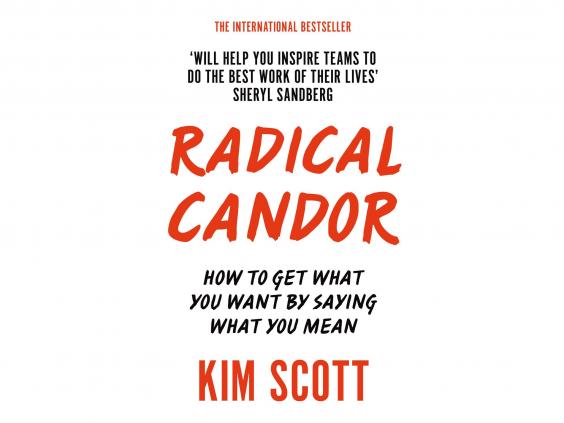
“Good communication is a vital skill any entrepreneur needs but what if you’re not confident dealing with the hiring and firing that comes with employing your own staff? Former Google and Apple executive Kim Scott draws on her years of experience in Silicon Valley to provide a guide to “radical candour” – in other words, how to be clear and firm with your employees without falling into false praise or aggression,” wrote The Independent.
Gmail’s Makeover And How It Can Influence Your Working Habbits
Google gave Gmail a big refresh that will change the way you interact with it and help you even more than before. As first reported by The Verge, the upgrade was revealed in a message from Google to administrators of G Suite accounts. The message stated that the changes would be coming to consumer Gmail accounts, as well as G Suite accounts.
The redesigned Gmail web interface is focused on quick productivity actions. Google is introducing features such as attachments chips, hover actions, and hover cards to make the static inbox experience more interactive without the need for multiple clicks. Google is also surfacing several labs features that were previously hidden in Settings > Labs, like canned responses, the ability to create multiple inboxes, and a preview pane to customize your preferences for different inboxes.
According to Fox News, Gmail is getting deeper G Suite interactions to directly create and edit Google Calendar invites, send notes to Google Keep, and manage to-do items in Tasks. “Google is also releasing new Tasks mobile apps for Android and iOS for adding and editing tasks from your smartphone to manage in Calendar and Gmail. The Tasks app is available today in the iOS App Store and Google Play Store. Aside from the new-look web app and Tasks mobile apps, Google also announced new security features, including Gmail confidential mode, and expanded AI capabilities like smart replies and notification priority settings,” added Fox News.
Here are some of the main changes and how they will impact you
Smart Replies and Smart Filtering
New AI-powered features in Gmail, like Nudging, Smart Reply and high-priority notifications, can now help you spend more time on work that matters. With Nudging, Gmail will proactively remind you to follow up or respond to messages, making sure you don’t drop the ball.
Smart Reply offers pre-set, one-line replies for any email. The replies are not just standard answers, but customized according to each email, due to machine learning, that suggest responses to you, in order to help you save time. Moreover, two new features promise efficiency improvements through smart filtering. Notifications for high-priority messages help you focus on your most important work. From now on, Gmail will pay attention to frequent newsletters and suggest you give them the boot by unsubscribing if you stop opening them.
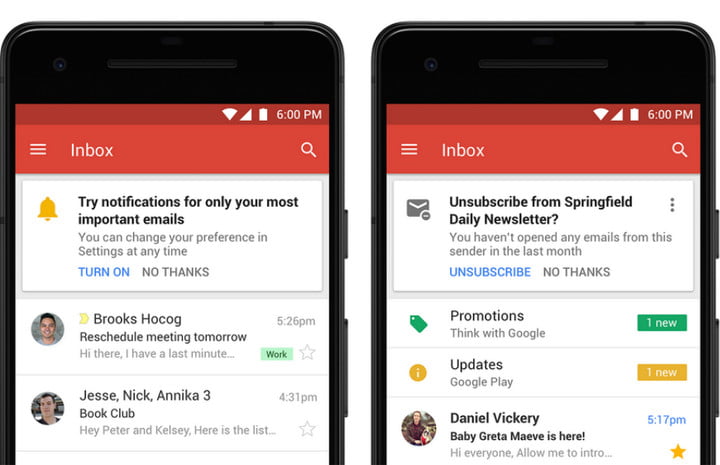
Protection from risky emails
Built-in Information Rights Management (IRM) controls also allow you to remove the option to forward, copy, download or print messages. This helps reduce the risk of confidential information being accidentally shared with the wrong people. Confidential mode will begin to roll out to consumer Gmail users and a limited number of G Suite customers in the coming weeks (broader rollout following).
Moreover, the redesigned security warnings within Gmail are simpler to understand and give a clear call to action to employees. These bigger, bolder warnings will help you be even more informed when it comes to potentially risky email.
“When you compose sensitive email you can remove options to forward, copy, download, or print the messages. The option to protect your outgoing email with two-factor authentication — the recipient needs to log into their own email and click to receive an unlock code via SMS text to read the message you sent could help you sleep better at night if you later discover their email account was hacked,” wrote Digital Trends.
Icons for Action Buttons
In the old Gmail interface, you’ll find the action buttons in the inbox along with a text label. In the new interface, Google has turned these action buttons into icons — you can’t read any text labels anymore. Also, this new icon menu has got two additional actions for quick access: Mark as read/unread and Snooze.
New Sidebar
It shows icons of other Google services like Calendar, Keep and Tasks. Tapping any icon expands the sidebar allowing you to quickly access your calendar entries, notes or tasks synced to your Google account. Any changes you do in these apps is synced back to the cloud and is instantly accessible on your other devices. You can also access third-party Gmail add-ons from the same side panel.
New native offline capabilities in Gmail on the web can help you work without interruption when you can’t find Wi-Fi. Search, write, respond, delete, or archive up to 90 days of messages, just as you would working online, but offline.
You can use Tasks to create tasks and subtasks, and even add due dates with notifications to help you stay on track. And because Tasks closely integrates with G Suite, you can simply drag and drop an email from Gmail into Tasks to create a to-do. Tasks with due dates can also appear in your Calendar. You can download the new Tasks mobile apps from the Google Play Store or iOS App Store today.
Different Display Modes
According to Economic Times, Google has added three view modes: default, comfortable and compact. Default view is ideal for large screens where you can open the preview of attachment in an email right from the inbox. This means you don’t need to open the email itself. Comfortable view is great for laptop users – it has large text which is easy to read sans the preview option of the default view. Compact view is the same as before.
All You Need To Know About The 5 AM Club
Some of us prefer to work in the morning, while others during the evening and night. We are used to say that the difference is made my our biorhythm. But what happens when you want to be more productive and have more time on your hands? What is the best formula to help you get forward? According to Psychology Today, several studies have shown that we function best physiologically and psychologically when our internal cycles are well-synchronized with those of the external world. If we mess up our sleep and wake patterns, for example, our mood suffers.
Alertness wanes and concentration falters. Memory gets shoddy. And performance on important tasks takes a dive. You don’t feel coherent, may not even be able to speak coherently. Physical well being suffers too. The immune system is compromised, leading to higher likelihood of a cold or flu. Hormones are in disarray, stomach problems arise. These are common complaints among those doing shift work, experiencing jet lag and suffering insomnia.
In addition to the body rhythms set to the day, there are other body rhythms occurring in cycles of shorter duration, often multiple times during the day. These are known as ultradian rhythms. With these, too, biological and psychological alertness and performance are very strongly correlated to the synchronization of your actions with the body’s natural patterns.
In the last years, there is a new trend and strong movement called “The 5am Club” that is trying to convince people that waking up at 5 am offers you a set of advantages over the rest of the people and, more than that, helps you become a better you.
The 5am Club by Michael Lombardi is a book about how to take advantage of your most productive time of the day, and how to prepare effectively both mentally and physically, to be ready for whatever the day throws your way. According to its writer, starting your day early gives you a leg up on others and gives you time to prepare yourself for your day before you are immersed in it. That quiet time early in the morning is a time to prepare you, body and mind, for a good start. That good start, in turn, gives you the chance to focus on positivity and ensure your day goes the best way possible.
It’s not as easy as setting your alarm for 5am, though. You need to manage your sleep effectively so that getting up so early does not take its toll on you. You need to manage your health, including food and drink intake to keep your body properly fuelled. And in addition, you need to minimize distraction in order to ensure a calm start to your day.
While there are many more personalities talking and writing about the subject,from Jeff Sanders and his 5am Miracle Podcast, and to Sharran Srivatsaa, probably the best known person for promoting the idea of The 5 am is Robin Sharma.
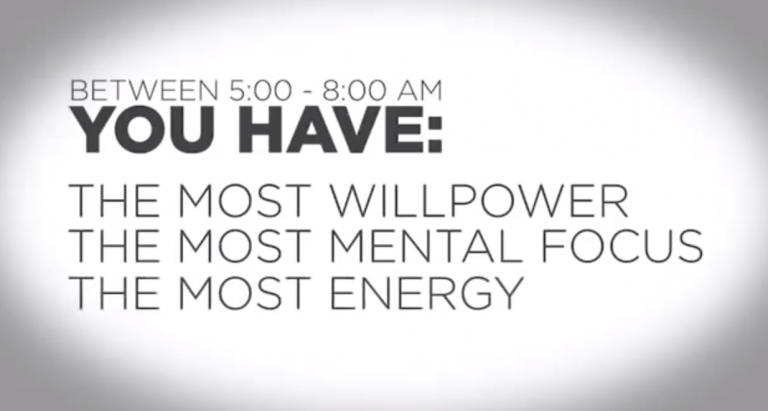
What has The 5 AM Club taught Robin Sharma about creativity and productivity:
1. When attempting to do a towering work that turns the industry on its head, you’ll feel like it’s not good enough, a lot of the time.
2. When you feel like quitting is the time you must commit to continuing.
3. Critics should move out of the way of people trying to get things done.
4. Procrastination is just your fear trying to divert you.
5. Fasting is an amazing practice to elevate your mental clarity, fireproof your energy and save a ton of time [and grocery expenses; joking…a little].
6. There is immense value, as you produce a project that you want to endure for decades, in getting lost from your usual life. You absolutely need to “go dark” so you get into the Flow State of mind that will deliver peak ideas to you. Major parts of The 5 AM Club were written in Rome, Russia, Brazil, Switzerland and Mauritius.
7. Get your creative tools right.
8. On the writing of this book, music was almost always playing as he worked on his craft. Music works to activate your best.
9. Reward yourself.
There is also an app, available in the AppStore.
In Romania, coaching on the subject is done by Dan Luca.
Why you should do it? Here are the main pros of the method:
- Bigger productivity
- More time for exercising, yourself and your loved ones
- Time for eating right and being present, enjoying every minute
- Getting the sleep at the right time when you need it
- Time to be the best at what you do

Online you can find several examples of people that state that starting their day at 5 am has changed their lives for the better. You can start from here, here and here.
Still, there are also plenty of people who believe that this isn’t sustainable on a long run or if you are just not simply cut out for it.


